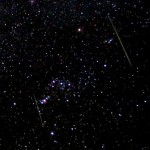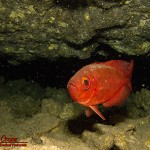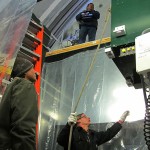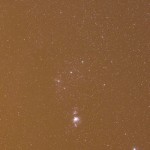The Moon and Venus were quite close last night, about 8° with the Moon below the brilliant Venus. Tonight the Moon will be above Venus, about 9° away.
Author: Andrew
The Moon and Venus
This evening a nice crescent Moon will join Venus in the dusky sky. The pair will be reasonably close, about 8° apart. Venus is currently shining very brightly at about -4.1 magnitude, contrasting nicely with a 9% illuminated Moon. The two will still be close tomorrow, about 9° apart with the Moon 15% illuminated.
Slipper Lobster
Meteor Watching
Watching meteors is one of the simplest forms of astronomical observing. Just about anyone can enjoy meteor watching, from just about anywhere in the world. Enjoying the show takes only a couple things… A dark sky and a comfortable place from which to watch.

The mechanism for the show is simple. When something hits the very thin air high in our atmosphere at very high speed it compresses the air in front of it. This compression also heats the air, causing it to glow white hot. Heated enough, the air becomes a plasma, the molecules shredded and electrons freed from the atoms. It is not the meteor itself that you see, but the glowing plasma around it.
There are a number of questions many people ask about meteor observing. You can find many of the answers below. Watching a meteor shower takes no special equipment, expert knowledge or extravagant preparation. This is an activity nearly anyone can enjoy, one of the spectacles of nature available to all.
Postcard from the Reef – Bigeye

New Moon
The Flight of OSIRIS
An incredible amount of planning and work went into the job, with everything culminating in a few days of frenetic activity. Often referred to as “twins”, the Keck telescopes seem anything but. Over the years these once identical twins have taken on their own characteristics. One of the things that differentiates the two, each has its own set of unique instruments. Cameras and spectrographs, these multimillion dollar devices allow the recording and studying of the light collected by the massive 10-meter mirrors. This week we moved one of these instruments from Keck 2 to Keck 1… OSIRIS.
OSIRIS is an infrared integral field spectrograph. Designed to take full advantage of the Keck Adaptive Optics systems, the instrument has a relatively small field of view. Within that small field it does amazing things, providing a simultaneous spectrum and image of an object. Essentially it takes a stack of images at the same time, each at a different wavelength. This gives astronomers a very powerful tool. One image will show the distribution of particular elements throughout an object. Using doppler shift, an astronomer can also observe how everything is moving within the object as well.

The Keck crew lowering OSIRIS into Keck 1 AO
Moving an instrument is not a trivial job. It is not simply a matter of unplugging the instrument and moving it to the other telescope. Each instrument has a tremendous amount of infrastructure required to support it. Electrical wiring, optical fibers, plumbing for the cooling systems, support computers, and more… All of it has to be moved.
OSIRIS has been a removable instrument, mounted to a handling cart for easy removal and installation into the telescope. The new installation will be a permanent mount within the AO enclosure. A new mount must be designed and fabricated. New support beams welded and bolted into place. There are openings to be cut into the floor for the mounts and support connections. Then all of the electrical, optical cabling and plumbing run through the structure of the telescope. This all has to be designed, reviewed and then the modifications performed without interfering with nightly observing. The amount of work is truly daunting, and thanks to the efforts of a great crew, now complete.
Keck Observatory Astronomer Wins Top Award
W. M. Keck Observatory press release…
A Keck Observatory astronomer who led the way to the discovery of a super-massive black hole at the center of our galaxy has been recognized this week with the 2012 Crafoord Prize in Astronomy, an award almost as prestigious for astronomers as a Nobel Prize.
“This is a big one. I’m thrilled,” said Andrea Ghez of the University of California at Los Angeles. For more than 16 years Ghez and her team have been pushing the frontiers of high-resolution imaging technologies with the twin 10-meter Keck telescopes in order to explore the center of the Milky Way. By tracking the rapid, small-scale orbits of stars at the Galactic Center, they discovered the presence of a source of tremendous gravity – the best evidence yet that a supermassive black hole exists there. The reality of such an object confronts and challenges our knowledge of fundamental physics.
Continue reading “Keck Observatory Astronomer Wins Top Award”
Most Distant Dwarf Galaxy Detected
W. M. Keck Observatory Press Release…
Scientists have long struggled to detect the dim dwarf galaxies that orbit our own galaxy. So it came as a surprise on Jan. 18 when a team of astronomers using Keck II telescope’s adaptive optics has announced the discovery of a dwarf galaxy halfway across the universe.
The new dwarf galaxy found by MIT’s Dr. Simona Vegetti and colleagues is a satellite of an elliptical galaxy almost 10 billion light-years away from Earth. The team detected it by studying how the massive elliptical galaxy, called JVAS B1938 + 666, serves as a gravitational lens for light from an even more distant galaxy directly behind it. Their discovery was published in the Jan. 18 online edition of the journal Nature.
Light Pollution Filters
Our neighborhood is a somewhat odd case. A large development surrounded by miles of empty land. Get just outside the neighborhood and the skies are quite dark. Inside the neighborhood one has to deal with the usual house lights and a plethora of streetlights. Still, I can see the Milky Way from the driveway, pick out M31 with the unaided eye, and make out a number of star clusters. There is one streetlight directly across the street from my front yard. A notable problem, only partly dealt with by way of a strategically planted Royal Poinciana. A few years old now, the tree has begun to shade the driveway from the worst local light source.
Despite the fact that the neighborhood is disgustingly overlit, there is a mitigating factor. All of the streetlights are low pressure sodium type lights. These lights emit all of their power at 589nm, a sharp emission which can be filtered at the camera. Filters for this and other common light pollution wavelengths are readily available from several manufacturers in a number of sizes and formats.

One minute Orion without LPR filter
While taking some wide field shots using a 50mm lens I had recent opportunity to see the difference with and without the filter. I did not have a filter that fit the 52mm thread on the lens, but rather simply set my 48mm filter on the front of the lens. I had not performed this simple experiment before as the usual mounting location of the filter is buried inside the setup. On this occasion it was a simple matter to take identical frames with and without the filter.
The resulting frames can be seen at the left. These are taken from the camera raw images, imported with daylight color balance, cropped and sized for display. Both images have been handled identically. Neither is a “pretty” picture, these are unprocessed images, none of the stacking, stretching and sharpening that would vastly improve the visual appearance.


